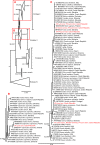Role of invasive carnivores (Procyon lotor and Nyctereutes procyonoides) in epidemiology of vector-borne pathogens: molecular survey from the Czech Republic
- PMID: 37408071
- PMCID: PMC10324142
- DOI: 10.1186/s13071-023-05834-w
Role of invasive carnivores (Procyon lotor and Nyctereutes procyonoides) in epidemiology of vector-borne pathogens: molecular survey from the Czech Republic
Abstract
Background: Vector-borne pathogens (VBPs) are a major threat to humans, livestock and companion animals worldwide. The combined effect of climatic, socioeconomic and host composition changes favours the spread of the vectors, together with the expansion of invasive carnivores contributing to the spread of the pathogens. In Europe, the most widespread invasive species of carnivores are raccoons (Procyon lotor) and raccoon dogs (Nyctereutes procyonoides). This study focused on the detection of four major groups of VBPs namely Babesia, Hepatozoon, Anaplasma phagocytophilum and Bartonella in invasive and native carnivores in the Czech Republic, with the emphasis on the role of invasive carnivores in the eco-epidemiology of said VBPs.
Methods: Spleen samples of 84 carnivores of eight species (Canis aureus, Canis lupus, Lynx lynx, P. lotor, Martes foina, Lutra lutra, Mustela erminea and N. procyonoides) were screened by combined nested PCR and sequencing for the above-mentioned VBPs targeting 18S rRNA and cytB in hemoprotozoa, groEL in A. phagocytophilum, and using multilocus genotyping in Bartonella spp. The species determination is supported by phylogenetic analysis inferred by the maximum likelihood method.
Results: Out of 84 samples, 44% tested positive for at least one pathogen. Five different species of VBPs were detected in P. lotor, namely Bartonella canis, Hepatozoon canis, Hepatozoon martis, A. phagocytophilum and Bartonella sp. related to Bartonella washoensis. All C. lupus tested positive for H. canis and one for B. canis. Three VBPs (Hepatozoon silvestris, A. phagocytophilum and Bartonella taylorii) were detected in L. lynx for the first time. Babesia vulpes and yet undescribed species of Babesia, not previously detected in Europe, were found in N. procyonoides.
Conclusions: Wild carnivores in the Czech Republic are hosts of several VBPs with potential veterinary and public health risks. Among the studied carnivore species, the invasive raccoon is the most competent host. Raccoons are the only species in our study where all the major groups of studied pathogens were detected. None of the detected pathogen species were previously detected in these carnivores in North America, suggesting that raccoons adapted to local VBPs rather than introduced new ones. Babesia vulpes and one new, probably imported species of Babesia, were found in raccoon dogs.
Keywords: Anaplasma phagocytophilum; Babesia; Bartonella; Carnivores; Hepatozoon; Invasive species; Vector-borne pathogens.
© 2023. The Author(s).
Conflict of interest statement
The authors declare that they have no competing interests.
Figures



Similar articles
-
Detection and phylogenetic analysis of blood-associated pathogens from spleen samples of wild raccoons (Procyon lotor) in Germany.Sci Rep. 2024 Dec 28;14(1):31232. doi: 10.1038/s41598-024-82581-7. Sci Rep. 2024. PMID: 39732827 Free PMC article.
-
Invasive raccoon (Procyon lotor) and raccoon dog (Nyctereutes procyonoides) as potential reservoirs of tick-borne pathogens: data review from native and introduced areas.Parasit Vectors. 2022 Apr 11;15(1):126. doi: 10.1186/s13071-022-05245-3. Parasit Vectors. 2022. PMID: 35410448 Free PMC article. Review.
-
Diversity of Anaplasma and Ehrlichia/Neoehrlichia Agents in Terrestrial Wild Carnivores Worldwide: Implications for Human and Domestic Animal Health and Wildlife Conservation.Front Vet Sci. 2018 Nov 23;5:293. doi: 10.3389/fvets.2018.00293. eCollection 2018. Front Vet Sci. 2018. PMID: 30533417 Free PMC article. Review.
-
High prevalence of vector-borne pathogens in domestic and wild carnivores in Iraq.Acta Trop. 2019 Sep;197:105058. doi: 10.1016/j.actatropica.2019.105058. Epub 2019 Jun 8. Acta Trop. 2019. PMID: 31185223
-
Circulation of Anaplasma phagocytophilum among invasive and native carnivore species living in sympatry in Poland.Parasit Vectors. 2023 Oct 18;16(1):368. doi: 10.1186/s13071-023-05996-7. Parasit Vectors. 2023. PMID: 37853498 Free PMC article.
Cited by
-
Detection and phylogenetic analysis of blood-associated pathogens from spleen samples of wild raccoons (Procyon lotor) in Germany.Sci Rep. 2024 Dec 28;14(1):31232. doi: 10.1038/s41598-024-82581-7. Sci Rep. 2024. PMID: 39732827 Free PMC article.
-
Vector-borne pathogens in dogs from the Republic of Kosovo.Parasit Vectors. 2025 Apr 9;18(1):136. doi: 10.1186/s13071-025-06777-0. Parasit Vectors. 2025. PMID: 40205569 Free PMC article.
-
Vector-Borne and Zoonotic Pathogens in Raccoon Dogs (Nyctereutes procyonoides) and Raccoons (Procyon lotor) from Schleswig-Holstein, Germany.Pathogens. 2024 Mar 21;13(3):270. doi: 10.3390/pathogens13030270. Pathogens. 2024. PMID: 38535613 Free PMC article.
-
Wildlife parasitology: sample collection and processing, diagnostic constraints, and methodological challenges in terrestrial carnivores.Parasit Vectors. 2024 Mar 13;17(1):127. doi: 10.1186/s13071-024-06226-4. Parasit Vectors. 2024. PMID: 38481271 Free PMC article. Review.
-
Occurrence of Recombinant Canine Coronavirus, Picodicistrovirus, and Circovirus in Red Foxes (Vulpes vulpes) Implies Frequent Virus Transmission Events Among Carnivores.Transbound Emerg Dis. 2025 Jun 4;2025:6681119. doi: 10.1155/tbed/6681119. eCollection 2025. Transbound Emerg Dis. 2025. PMID: 40503221 Free PMC article.
References
MeSH terms
Grants and funding
LinkOut - more resources
Full Text Sources
Research Materials
Miscellaneous

